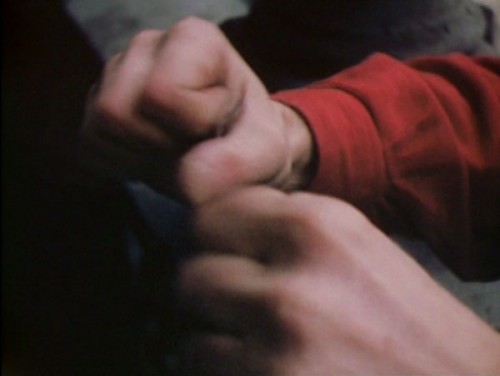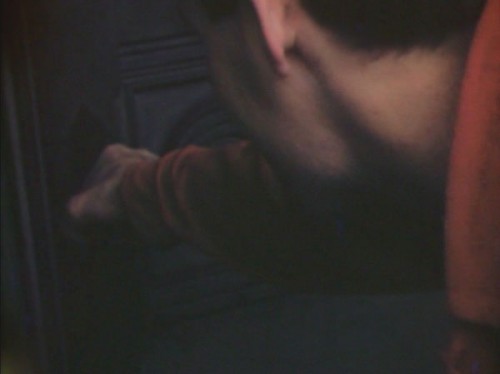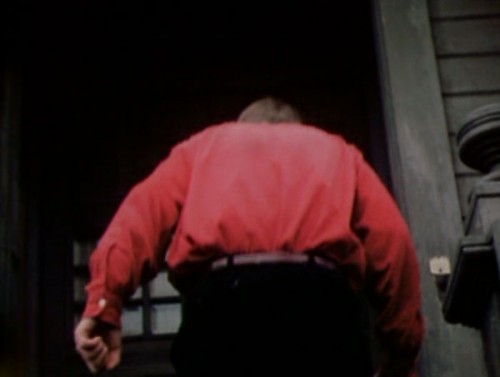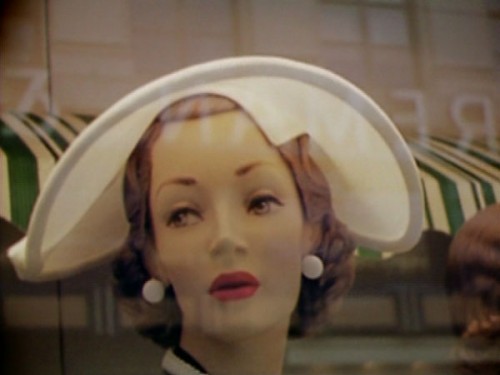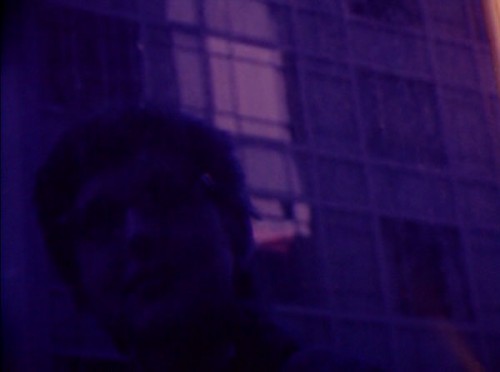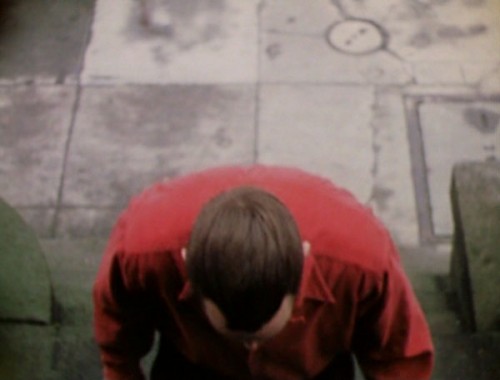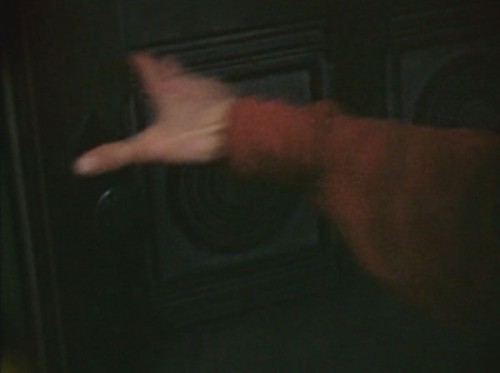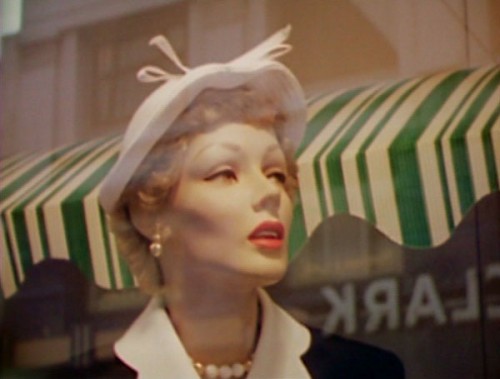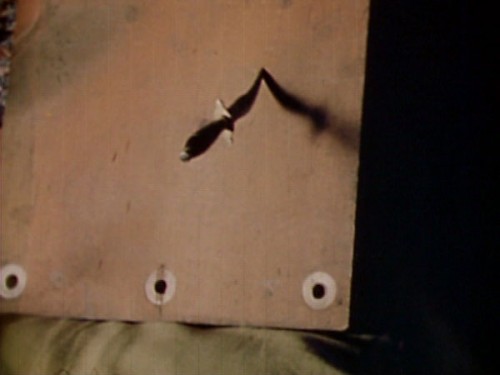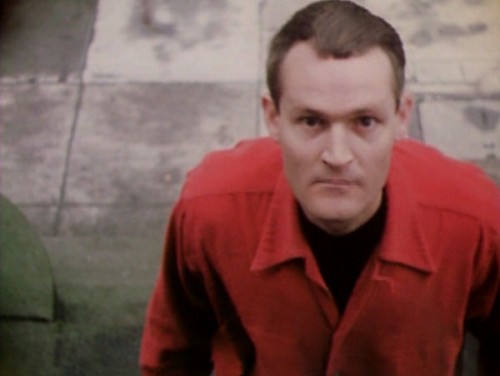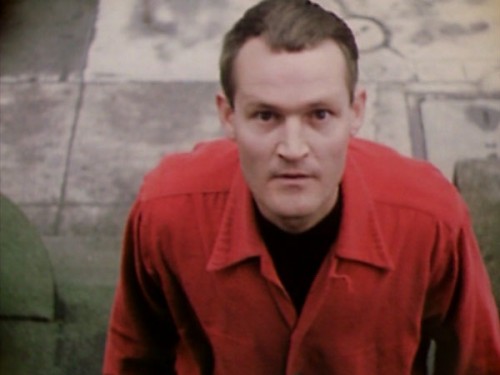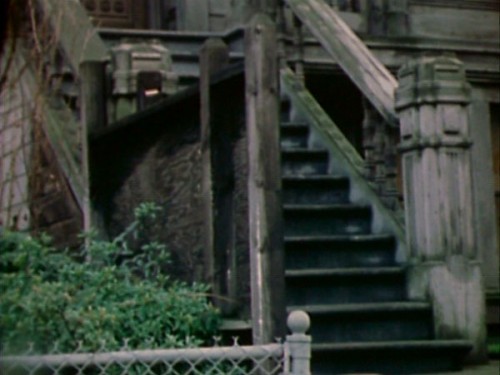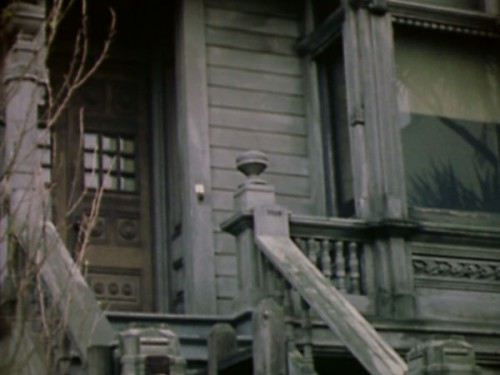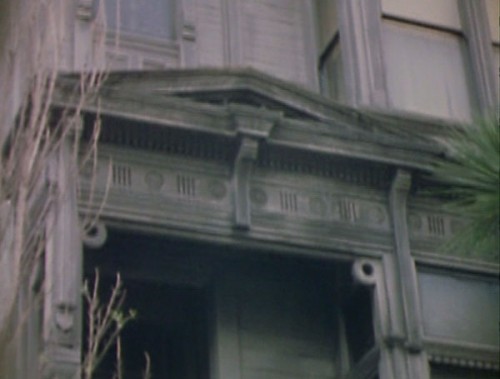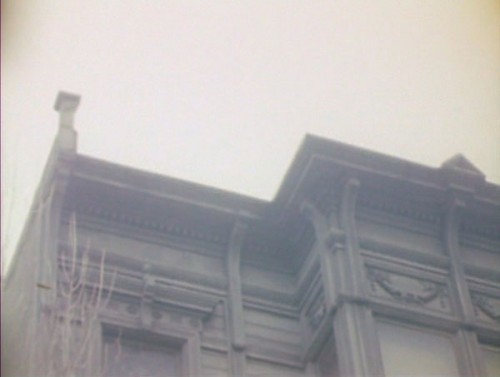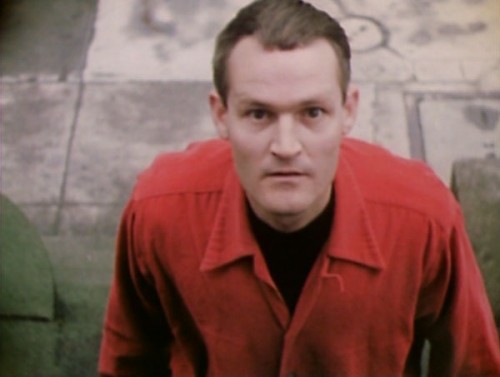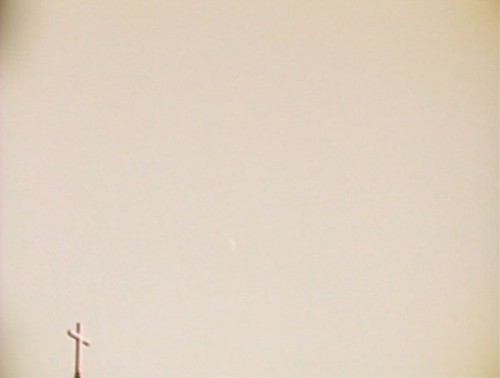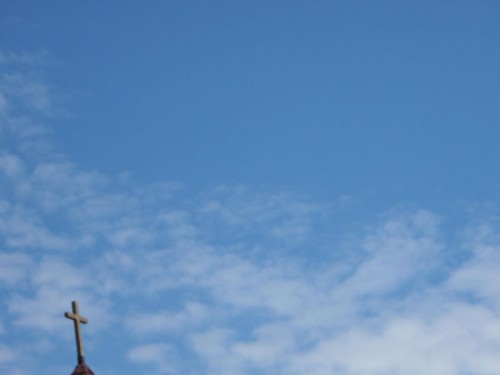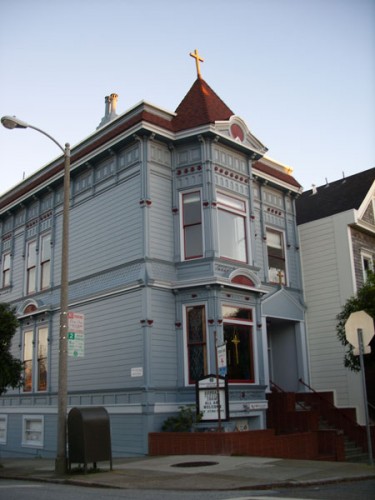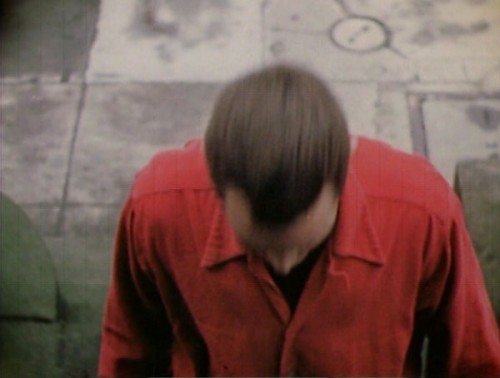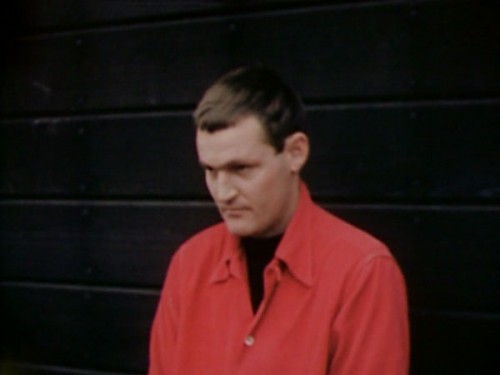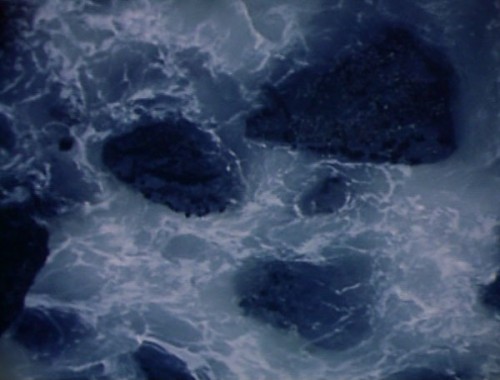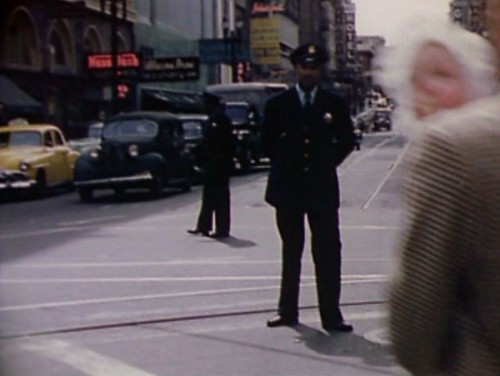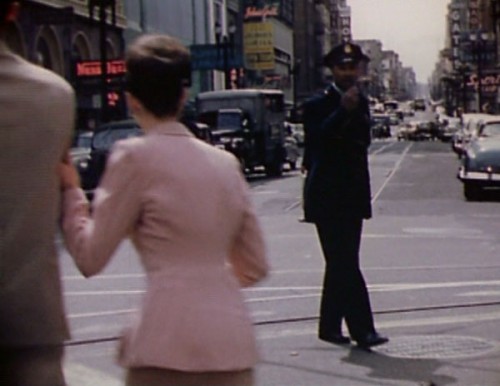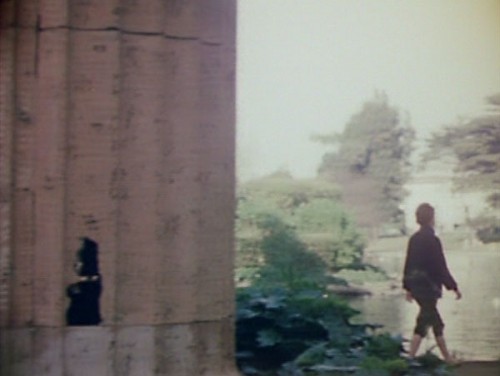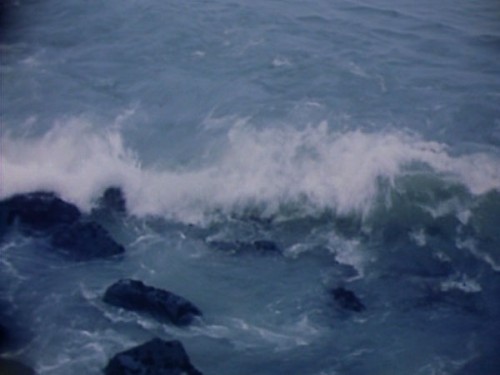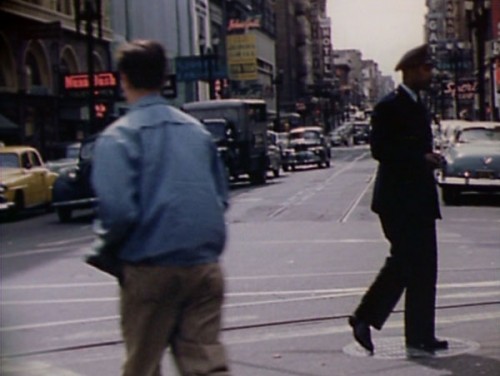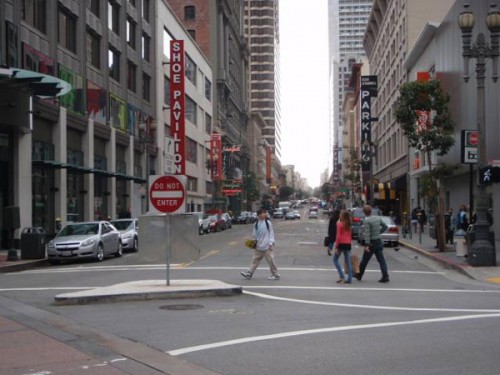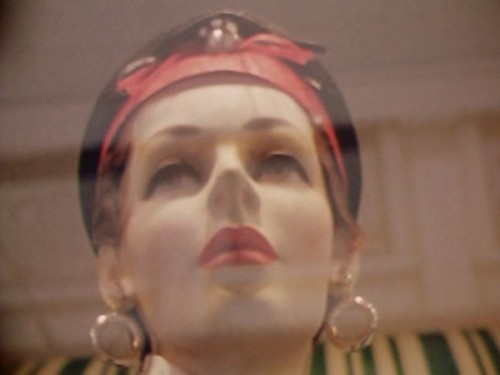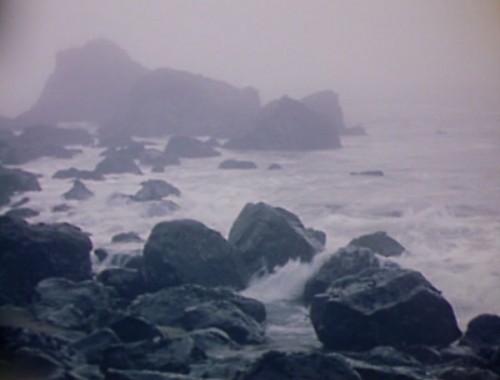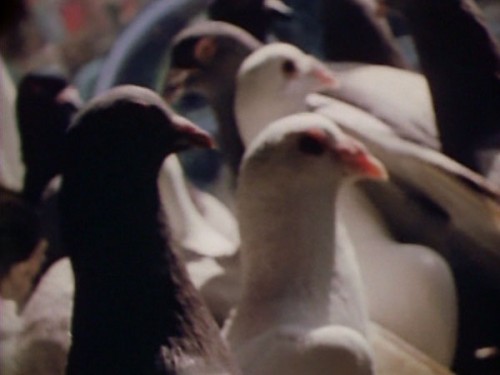In Search of Christopher Maclaine 14: The THE END Tour - A Work in Progress 12: CHRIS B
This is the fourteenth in a multipart series unofficially conjoined to the publication of Radical Light: Alternative Film & Video in the San Francisco Bay Area, 1945–2000, and the accompanying film series currently being presented by the Pacific Film Archive and San Francisco Cinematheque (in partnership with SFMOMA).
With my friend Brian Darr, proprietor of the great Bay Area cinephilia blog Hell on Frisco Bay, I’ve been scouting out the San Francisco locations used in Christopher Maclaine’s Masterpiece, THE END. What began as an attempt to identify and document what physically remains of the often mysterious places at which THE END was shot has evolved into a larger project to also analyze the film, and to identify all its many actors and extras, all of whom appear uncredited. To read the full version of these preliminary remarks, including info on how YOU can participate in this project, click here. For further information on Maclaine, check out the intro, which serves as this series’ hub. For the previous post of this Tour, click here.
NEW FEATURE: a YouTube of the CHRIS episode is viewable here.
NOTE: portions of Maclaine’s Voice-Over narration are transcribed in italicized sections. The images, for the most part, are stills documenting many (but by no means all) of THE END‘s shots. Those unfamiliar with this film will probably want to watch the video clip found above first, before making their way through the (hopefully enjoyable) notes and explication.
We now take up from the end of CHRIS A, which saw our current protagonist, played by THE END‘s auteur, Christopher Maclaine, about to ascend the front stoop of a mysterious house with seemingly malevolent intent.
36) CHRIS ascends the stoop. From the shot seen in image 30 (scroll down), our “Character” has been engaged in a crazy comedy of repeatedly approaching the house and beginning to walk up its front stairs, only to find himself returned to his starting point, then setting off anew. Chris’s performance style as “A Character” is that of a natural (and probably practiced) physical comedian, akin somewhat, in its cartoonishness, to something one might see in a film by Frank Tashlin, the great director of Hollywood comedies in the ’50s and ’60s. Like Maclaine’s, Tashlin’s work deeply registered the madness of their era. (Interestingly, Tashlin was also the author/illustrator of several what might be called “mock children’s books” for adults, including THE WORLD THAT ISN’T (1951), in which a humanity grown wise to its collective madness explodes a nuclear bomb, dumps all its technology into the resulting crater, then creates a primitive Rousseauian utopia.)
37) “A Character’s” hands are pulled back from a gesture apparently inspired by a desire to cause mayhem. A version of this shot had been seen as part of the introductory montage.
38) Chris reaches into the frame to open the mysterious house’s front door. This gesture will be twice repeated in this dream-like sequence — as I mentioned towards the end of the last post, “the obsessive, flirting with psychosis, has an internal repertoire of such cherished images, which both console and spur him or her along the mad path.” The repetition of these images also further engages us in Maclaine’s Voice-Over request to his audience to “write this story” by attempting to figure out just “what is happening.”
Someone is in the house.
39) For the second time from this camera angle, Chris determinedly marches up the stairs.
Although much criticism of THE END (even by admirers) has focused on his supposed “amateurism,” as evidenced, for example, by his often bizarre and radical editing style, this sequence is one of many to reveal Maclaine to have a full understanding of traditional continuity editing. As Chris walks up the stairs time after time, there are no violations of the 180° rule which would confuse the viewer, causing him or her to be uncertain of our “Character’s” orientation within the fictive space the filmmaker creates. Similarly, and perhaps even more tellingly, Maclaine in this sequence regularly cuts on action, at least in dealing specifically with “A Character’s” movements in relation to the house. Cutting on action is one of the most powerful tools in the classical editing arsenal towards creating the illusion of a subject’s continuing movement through space, and rather than simply a matter of following “rules,” requires a craftsman/artist’s intuitive sense of how to finesse the cuts, and thereby create the illusions. Instead of this being the case of an artist whose brilliant content suffered from incompetent craftsmanship, Maclaine’s genius is possibly most evidenced by his deliberate, though inconsistent, choices to disrupt illusionism — artistic choices that, through their influence on Stan Brakhage and others, have long since become part of the language of all those who wish to engage in formal experimentalism within the film medium.
Although Maclaine’s editing betrays total fluency with normal practices, in this sequence, as throughout much of the film, it is undeniably disruptive. “What,” exactly, “is happening?” Maclaine fluidly cuts between a variety of apparently haphazard, disparate imagery and shots of his “Character” seeming to: a) be moving up and down the stairs while trying to build up his courage to take action of some kind, or b) fantasizing regarding taking such action, for which we are provided representative images. There is also possibility c) in which Maclaine, similar to his technique during a portion of the PAUL episode, is cutting back and forth in time as “A Character” commits the simple action of moving up the stoop, and attempting to enter the house one time only. While this latter case is the least likely, as the individual movements by “A Character” are clearly variations on each other, rather than the shots being repeated versions of precise moments in time, there is, in fact, no reason why a, b, and c can’t all be at work simultaneously. THE END, with Maclaine’s own brand of Eisenstein-informed metaphorical/associative montage, is perhaps the first narrative film to systematically work in the complex poetic/dreamscape-laden/time-shifting manner that would become a major cinematic mode with such later works as Resnais’s HIROSHIMA MON AMOUR (1959) and LAST YEAR AT MARIENBAD (1961), and the major works of Nicolas Roeg, running from PERFORMANCE (1970) through EUREKA (1983). (Intriguingly, the first of these films cited, HIROSHIMA MON AMOUR, like THE END, was also a response to the psychic fallout of the Atomic Age.)
But again, “what is happening?” or rather, why is it happening? Similar to the JOHN section, and the later PAUL episode, the confusing mix of fractured lyricism and intimations of violence we have thus far encountered in the CHRIS segment leads us, as discussed when dealing with those previous episodes, to an “at least subconscious awareness of the infinite contraries of the universe,” and serves as the opening salvo in what will prove the film’s ultimate “barrage” of “jolts” “bringing us ‘to awareness of participating in both illusion and disillusion, and hence, awareness, conscious or not, of the mystical union of opposites.’ ” From Walter through Paul, we have progressed through Dante-esque realms analogous to Inferno and Purgatorio, and are now prepared, perhaps, for a direct confrontation with the Divine. As Chris storms up those steps bent on frenzy, could he and we be on the verge of entering a Paradise in which the ecstatic and orgasmic are ineluctably yoked together?
Why is he hesitating?
40) Maclaine cuts to yet another mannequin from the window display first seen in image 37 of the WALTER episode, and more recently in #19 from the last post, CHRIS A. This mannequin-anima figure is even more beautiful and sad than the one from WALTER. Does she represent for our “Character” the “someone” “in the house”? Is he “hesitating” at the thought of her response to his imminent violence?
Why is he going into the house?
41) We again see the short-dark-haired anima-figure (actress unidentified) last seen in #28. As before, she seems to scrutinize Chris’s potentially rash behavior, this time clearly more with curiosity than judgment.
Maclaine’s “Eisenstein-informed metaphorical/associative montage” is exemplified by his pressing the mannequin from 40, above, and this very amiable-seeming woman into roles that they could hardly have been designed for, or aware of. The film’s narration, interacting with its very often non-literal imagery, creates malleable networks of unexpected meaning in the hands of this most dexterous filmmaker.
42) An overhead shot as “A Character” reaches the stoop’s landing. Please keep this image in mind — it will prove strong evidence in the case for Maclaine — often accused of “naïveté” and “amateurism” on the basis of THE END — as an already technically sophisticated, though neophyte, filmmaker.
Now, he will …
43) “A Character’s” hand reaches into the frame to make a play at opening the door of the house, then is violently withdrawn.
… enter, and …
44) Maclaine cuts to the shot of the blond mannequin-anima figure previously seen in image #19, which I described as “beautiful,” but “somewhat aloof-seeming.” At that point, I wondered if “A Character” found her “glassed-in, impenetrable lifelessness frustrating?” Now, let us also notice her strand of over-sized artificial pearls. The pearl, from time immemorial, has been a symbol of feminine purity; in the modern era, it is often associated with the wealth, status, and sexual exclusivity of the society matron. In the Victorian era, “pearl” was apparently a slang term for clitoris.
In the Analytical Psychology of C. G. Jung, to which this Tour subscribes, feminine imagery provokes within the male psyche, as I’ve put it elsewhere, “contemplation of the inner rose — the soul (understood either literally or as a metaphor for an inherent part of the psychic structure).” (For women, Jung employs the contrasexual term “animus” to describe the spirit or soul, which is masculine in character.) We have been given much evidence throughout the CHRIS episode, as with all the “Maclaine men,” that our “Character” is estranged from his soul, and, in his case, also from a particular woman who serves as a vessel for his “soul images.” Does he seek to storm a “Paradise in which the ecstatic and orgasmic are ineluctably yoked together” (as I described it above) by means of forced “entry” into this woman?
… destroy …
45) From the blond mannequin in pearls seen in 44, immediately above, Maclaine cuts to another shot of “A Character’s” hand making an attempt to open the door, then jerking away. Afterward, we are treated to this flashcut of his knife in the board, which we’ve seen several times previously.
By “perhaps” (see below) seeking to “enter and destroy” his anima, and gateway to Paradise, does “A Character” reveal yet another version of the suicidal penchant characteristic of all previous “Maclaine men”?
… perhaps?
46) We cut back to the overhead shot of Chris, as “A Character,” on the landing. His head swings upwards to look directly at the camera, revealing a visage awash with seeming psychotic malice.
Listen, I know no more about this story than you do, but I …
47) As if Maclaine has cut to “A Character’s” POV in his psychotic break from reality, the image goes to black. After a brief moment in which we hear only Beethoven, Maclaine’s voice returns to the soundtrack in the guise of the absurdly in-the-dark narrator he’d played in the CHARLES episode.
By suddenly going to black, and (as in #10’s call for “you to write this story”) claiming to “know no more about this story” than we, Maclaine compounds THE END‘s metafictional thematic and tactics.
Once again, I ask you — did Maclaine invent postmodernism?
… do know that at this point …
48) We return to the camera angle from 46. “A Character’s” expression transforms itself suddenly from psychosis to awe.
It’s now time to deal with the matter brought up in #42, above — evidence of Maclaine’s technical sophistication as a filmmaker. Notice the staircase seen behind Chris (less obscured by his figure in picture 42). It is made of stone.
49) Maclaine cuts to a reverse angle of the house. The stoop here, however, is clearly not the one portrayed in the shots of Chris’s legs walking up the steps, and also seen in the overhead angle looking down at him. Those are made of stone, and have an apparently low railing, while these are wood, and have a relatively high railing. After a brief moment, Jordan Belson’s camera begins tilting upwards …
… he is suddenly both blind and deaf …
50) … coming to a rest momentarily at the house’s front door, to reveal — no Chris! Has “A Character” suddenly “both blind and deaf” been simultaneously rendered invisible? Again, “what is happening?” As so many times before, we are brought “to awareness of participating in both illusion and disillusion, and hence, awareness, conscious or not, of the mystical union of opposites.” My bet, however, is that here the awareness is largely subconscious, for Maclaine is especially concerned here not with disillusion, but illusionism and the working of Miracles. As we are told of one miracle — “A Character” becoming “suddenly both blind and deaf” — we see another: “A Character” not being where he logically should. But, for this viewer at least, the illusion works — “A Character” seems to be on these stairs, and this appears to be the house he looks up at. Perhaps I accept this illusion readily from having seen THE END far more than any rational person would have, but I believe that what Maclaine is doing here is prepping us to accept Metaphysical Miracles by engaging us in the Miracle of cinematic illusion. Cutting from a shot of someone looking directly at us to one of what he ostensibly sees ties directly into the underlying mechanism of the psyche’s ability to orient itself in space. By tapping into a phenomenon rooted in the depths of our natures to create this illusion of “A Character” having a direct relationship to the house even though he’s not in the position where he should physically be, Maclaine renders Miracles subliminally believable. For me, no further proof of Maclaine’s cinematic Wizardry is required.
… and he takes this as a message from Somebody …
51) Belson’s camera continues its upward tilt. Aside from thematic/formal issues, on the level of practical filmmaking concerns, a stoop from another house may have been chosen to provide a wider staircase for the necessary shots of “A Character’s” legs making their ascent. The other house may have also provided a more convenient situation from which to secure the desired angle seen thus far in pictures 42, 46, and 48, in terms both of its distance from the landing, and amount of space in which to mount the camera. These shots may have been photographed through, or leaning out of an open window situated relatively lower than that of the third floor window seen here.
… he’d better accept as Master, and a-walks …
52) The camera completes its tilt, bringing into view a post or marker on the roof resembling, or which actually is, a cross.
… away …
53) A flashcut of “A Character” dumbstruck, from the angle previously seen in 42, 46, and 48.
… from the house and its occupant.
54) The flashcut of our “Character” seen in 53, above, serves to join the cross or cross-like marker seen atop the house in 52 to this shot of what appears to be a cross jutting from the roof of a church. As compared with other recent shots in this sequence, this shot is held for quite some time while Beethoven’s 9th soars. Does this church cross render our mysterious house a church? The “Somebody he’d better accept as Master” is, obviously, God. (In 1999, referring to Maclaine and this moment in THE END, Stan Brakhage said to me: “he’s so mystical, he can’t even use the word ‘God.’ “) Is the “occupant” of the house rendered by the cross a “House of God” actually “the Occupant”? Has “A Character,” in attempting to storm Paradise with violent intent, offended God? Or perhaps the Goddess, who clearly has been presented with much by which to take offense? Although the cross is an inherently Christian sign and symbol, I believe (for reasons which will become clear before too long) Maclaine’s metaphysic not to be especially Christian, and that he uses the cross (a symbol that to my knowledge doesn’t reoccur in his work) as a shorthand sign for “God.” Nevertheless, there are some specifically Christian elements to THE END that I would be remiss not to note: all of the film’s exclusively male rotating protagonists up to this point have been seen at climactic points of socially-imposed cavalries towards self-imposed crucifixions. (The crucifixion symbolism was especially of note in the case of JOHN.) THE END‘s protagonists are all flawed men living in a fallen world. At this point of the CHRIS narrative, we are amidst the process of “A Character,” despite his flaws, or perhaps even because of them (it cannot be for us to know His and Her ways), receiving the much-needed grace of God (and/or Goddess). We are witnessing a Miracle.
55) A recent photo.
56) The cross in 55, immediately above, rests atop San Francisco’s Sei Ko Kai Christ Church, located at 2140 Pierce St., at Clay. This church was founded in 1895 by Nippon Sei Ko Kai, the Japanese branch of the Anglican Communion. (I was reminded a year-and-a-half-ago, btw, via a PFA screening of Nagisa Oshima’s brilliant SHIRO AMAKUSA, CHRISTIAN REBEL, that the history of Christianity in Japan goes back to the 16th c. The Anglican Communion in Japan, however, dates from two hundred and more years later.) Here is a webpage which sketches in the history of Japanese organized religion in San Francisco.
For years, in my occasional wanderings about the vicinity of Alta Plaza Park, and especially its grand four-tier south central stairway, I’d look up to spy this cross, and wonder could it be? In the years before I’d even found Alta Plaza, when viewing THE END and contemplating the possibility of sussing out its locations, the isolated cross we see in 54 was an item I thought could surely never be identified. But in my repeated visits, I was always struck by an uncanny familiarity. When Brian and I began location scouting for this Tour, Alta Plaza Park was one of the first places we visited. Independently and unprompted, Brian looked up from the bottom of the grand stairway and pointed. “Is that … the cross?” he asked. “I’ve been wondering about that for a long time myself,” I said. “It sure looks like it. And if this occurs to us both separately, it almost has to be …” There can never be any definitive proof (other than, perhaps, confirmation by Jordan Belson) that the leaning cross of 55 is the one and same as the straight, stiff-as-a-soldier-at-attention cross of 54, but personally I’m convinced. Our snapshot shown in 55 was taken nearby the bottom of the grand stairway. After doing the b&w shot of WALTER running up the staircase, it would have been the easiest thing in the world to swing the camera around to do the shot of the cross. In fact, the sunlight appears to be coming from the appropriate direction if the locations of the stairway and cross are adjacent, and if these two shots were done at roughly the same time of day. Here is Sei Ko Kai Christ Church’s current congregation, photographed across the street, arrayed on the stairway. The church moved to its current location — presumably erecting a new straight and stiff cross in the process — in 1952, the year we believe production on THE END began.
57) Our “Character” bows his head in submission, an act anticipated in #26.
58) A contrite Chris in the midst of a Vision.
59) We cut to a montage of “A Character’s” mindscreen imagery. This first image is of tidewater lapping against rocks. The shot has been edited into the film backwards, rendering the picture upside-down and in reverse-motion.
60) At the intersection of Ellis, Stockton, and Market Streets, a traffic cop looks directly at the camera as a man enters the frame holding a baby.
61) The white baby, father, and mother move through the frame as the traffic cop brings a whistle to his lips. The cop appears to be African American, a most unusual circumstance circa 1953. According to BLACK POLICE IN AMERICA, by W. Marvin Dulaney, there were only five African American officers on the San Francisco police force as of 1950; there were only eighty-five twenty years later, in 1970.
62) After another bit of upside-down and reverse-motion tidewater against rocks, we see the anima-figure at the Palace of Fine Arts from #15. She appears from behind an only slightly damaged column to parade in the streaming sunlight.
63) Right-side up, and in normal motion, a small wave crashes onto a rocky shore.
64) Another pedestrian crosses the frame as the traffic cop spins around in a dance-like motion. In the distance of this shot can be seen the neon sign of John’s Grill, a restaurant made famous by being featured in Dashiell Hammett’s novel, THE MALTESE FALCON (1930).
65) A recent photo of the Ellis, Stockton, and Market streets intersection, from a bit farther back, and with a more wide-angle lens than the Maclaine/Belson shot depicted immediately above, in 64. Much has changed on this street, but John’s Grill is very much still extant.
66) At this climactic point of this section of the CHRIS episode, Maclaine returns to the mannequin first seen in image 37 of the WALTER episode. The cinematic narrative of our “Character” has been awash with such anima imagery, and it is emotionally apt for us to return to this “woman” I described as “beautiful and sad.” Her appearance in Walter’s story was somehow tied into his crack-up; her present return is the climax of “A Character’s” mystical Vision (or, as we shall see, to at least the prelude of this). As Beethoven’s 9th continues to soar in the background, is she perhaps somehow more beautiful, and less sad? The “Maclaine man” has reconciled to his anima, and become whole.
This may be an appropriate point to discuss Maclaine’s use of feminine imagery throughout THE END. For the past thirty years or so, American culture has experienced a wave of political iconoclasm in which images of woman have been subject to critique regarding their social validity and utility. Undergirding this Tour, on the other hand, is an understanding of archetypal psychology derived from C. G. Jung, and others, which sees the gender-based and sexually-charged imagery floating through our psyches as key parts of our inherent psychic structures, or as the results of these structure’s interactions with life experience. We can no more escape — in any kind of ultimate sense — archetypal perceptions than we can psychological projection, by which we foist onto the world our own emotion-fueled understandings and personal biases. In this vale of tears, the individual’s only hope is to plunge into the world of inner images; by such means psychic/spiritual reconciliation and individuation are possibly attained. These days, one’s celebration of feminine imagery counts as another’s “misogyny,” but fortunately for Christopher Maclaine, he wasn’t subject to such concerns in the mid-’50s. A brave artist of the 20th c., he intuitively knew his female or feminine subjects to be parts of his own psyche, rather than individuals in the social world whom he had some responsibility to depict “realistically,” one of the theoretical banes of modern media concerns.
Then the world and its music comes …
67) Maclaine follows the anima-image of 66, immediately above, with another image last seen during WALTER‘s supernova: Seal Rocks can be seen in the distance, as waves wash over smaller boulders in the foreground.
… back to him, and he hums a little song, and hears an echo …
68) From images 59–64, and 66 to our current 68, we have been treated to Chris’s/”A Character’s” Vision: the tides have gone in and out, backwards and forwards, upside-down and right-side up. Water interacts with stone. A black traffic cop has wielded God-like benevolent power in a society dominated by whites. We see parents and a child. Chris reconciles to his anima, who’s set free under the sun. The Goddess is re-enthroned. Black pigeons consort with white.
How’s that for “the infinite contraries of the universe” and a “mystical union of opposites'”? The mystical experience often involves a vision of cosmic order, in which all the “contraries” and “opposites” are reconciled, and the visionary is put into ecstatic connection with the cosmos. We have passed through the gates of Paradise — a Vision uniting the ecstatic and orgasmic is coming into view …
All this had been foreshadowed by, amongst other things, the shots of pigeons scattered throughout our “Character’s” narrative.
Ah … So THAT’S what you were up to with all those black and white pigeons, Chris …
Click here for “A Character”‘s Vision continued in CHRIS C.
Click as indicated for the previous post of this Tour. Click as indicated for the intro to this series.
Click here for an interview with Stan Brakhage concerning Maclaine, circa 1986.
If you have any information or (nonpublic) feedback to contribute to the Tour, please click here.

